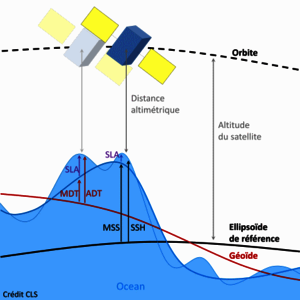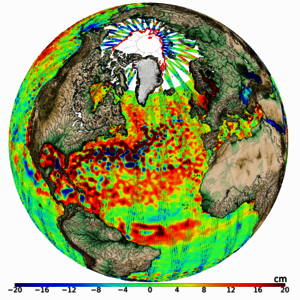Sea heights


Sea heights are the elevation of the sea surface relative to a reference surface (reference ellipsoid, geoid). These sea levels can be calculated according to different time references, depending on whether they include an instantaneous value (at a t time) or a change over time (dh/dt) or a reference period.
Sea surface heights at a t time
SSH is commonly referred to as sea surface heights observed at a t time, when they are referenced to a geometric reference, the reference ellipsoid. This is directly deduced from the altimeter measurement: SSH = satellite altitude (orbit) - altimeter distance (range).
We also distinguish the absolute dynamic topography at a time t (ADT), i.e. the sea surface heights expressed in relation to the geoid at a time t.
SLA : sea level anomalies at t time correspond to a sea level minus an average of sea levels calculated over a reference period (see MSS). They are referenced to the reference ellipsoid. They give the image of areas where the heights are higher (positive anomalies) or lower (negative anomalies) than the average.
All these surfaces are linked by the following equations (where p denotes a reference period):
Sea surface heights expressed over a given period
MDT : The average dynamic topography is the average height of the ocean relative to the geoid. This average is calculated over a reference period long enough to avoid interannual fluctuations. It is the image of the oceanic relief corresponding to the permanent ocean circulation.
MSS : the mean ocean surface is the average height of the ocean relative to a reference ellipsoid. This average is calculated over a reference period long enough to avoid interannual fluctuations. The MSS is the average of the SSH over a given reference period.
MSL : Rise in mean sea level corresponds to a change in sea level over time. It is therefore always expressed with a reference in time. In 2017, this rise is 3.29 mm/year over all the oceans. According to observations, this elevation has reached 8 cm since 1993. In 2017, models, in their most extreme scenarios, estimate an increase in mean sea level over all oceans to more than 2 m by 2100.
Because it integrates the response of several components of the climate system (thermal expansion of water due to its warming, melting of polar ice caps and glaciers, contribution of continental waters), sea level is one of the most important indicators of global warming.
More information
- on the DUACS website: reference surfaces et reference surfaces
- on the SHOM website for reference surfaces relative to coastal references incorporating specific levels, such as lowest sea levels, hydrographic zero.




